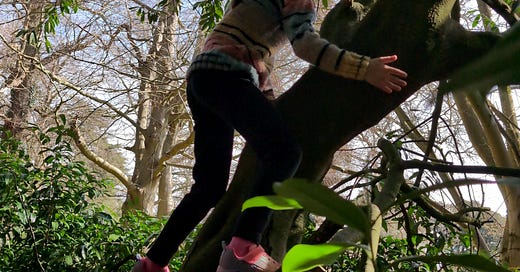Having an understanding of why outdoor play is important is one step along the journey towards spending more time outside each day. But what about the things that can be off-putting when it comes to spending more time outside?
One of the biggest issues we face as parents is keeping our children safe. Our natural urge is to protect them and keep them away from danger. Sometimes, we can go too far with this and keep our children so safe that they don’t do anything remotely risky.
As a former helicopter parent myself, I know that finding the right balance between letting your child explore and keeping them safe can be hard.
Simply watching a short Reel can give off the wrong impression about what risky play is, so I wanted to explore what is is in more detail.
What You’ll Learn in this article:
What risky play is
Why risky play is important
The difference between risk and hazard
Health & safety considerations
Creating an Outdoor ‘Yes Space’
Why be careful doesn’t work
When to interrupt play
Dressing for play
Following the Child
This newsletter is part of A Playful Year which is exclusive to paid subscribers. To access the content, including printable resources and guides, please click the link below.
First, what do I mean by risky play?
In some ways risky play is just play. It is just children doing what they're naturally inclined to do, taking things to the next level. So in some ways, I think of risky play as play that makes us adults nervous.
Rusty Keeler, play space designer and specialist in risky play, speaking at the 2021 Fairy Dust Teaching Conference
There are 6 main elements to risky play:
Interaction with nature - e.g. building a den
Speed + momentum - e.g. cycling downhill
Height + elevation - e.g. climbing to the top of a tree
Play with a chance of getting lost - e.g. hide and seek games or orienteering
Rough + tumble play - e.g. play fighting
Use of tools - e.g. using a hammer
Whilst the idea of risky play has gained in popularity in recent years with lots of outdoor experts espousing the benefits, it is of course nothing new. In fact, as children it’s likely that we simply considered it to be ‘play.’
My dad (now 82) often tells stories of rambling across the Welsh mountains with no adult supervision, and whilst my 80s childhood was tamer than that, I do remember using the rather precarious rope swing tied to a tree by the local canal.
Typically today, our children take fewer risks than we did as children. Or perhaps it’s fairer to say that those opportunities to engage in risky play has been taken away from them. There are many reasons for this such as both parents working, the promotion of organised sports, suing culture and the societal attitudes towards parenting (the fear of being judged as a ‘bad’ parent).
Play for the sake of play has become an endangered species. It’s now restricted to assigned areas where children must be “so tall” to enter. Playground floors have been replaced with rubber surfaces—because God forbid a grass stain. And heaven help our children if they play at the wrong scheduled time.
Ainsley Arment, The Call of the Wild and Free: Reclaiming the Wonder in Your Child's Education
All of the above means that we now need to make opportunities for risky play via weekend adventures or Forest School memberships, rather than it being part of daily life.
Why is Risky Play Important?
Risky play helps children to build resilience. Each time they play in a risky way, they are discovering their own abilities, building up their strength and honing their executive functioning skills.
Risky play enables children to do their own risk assessments, understanding what an appropriate level of risk is for them.
Ultimately, risky play is NOT about having no fear at all.
Children need to have an understanding of where their limits lie. They are not able to do this if they never have the opportunity to experiment.
Risky play also gives a huge boost to a child’s self-confidence. When they achieve something that they previously ‘failed’ at, it can put a real spring in their step.





